from 0 review
4 Night 5 Day
Daily Tour
10 people
___
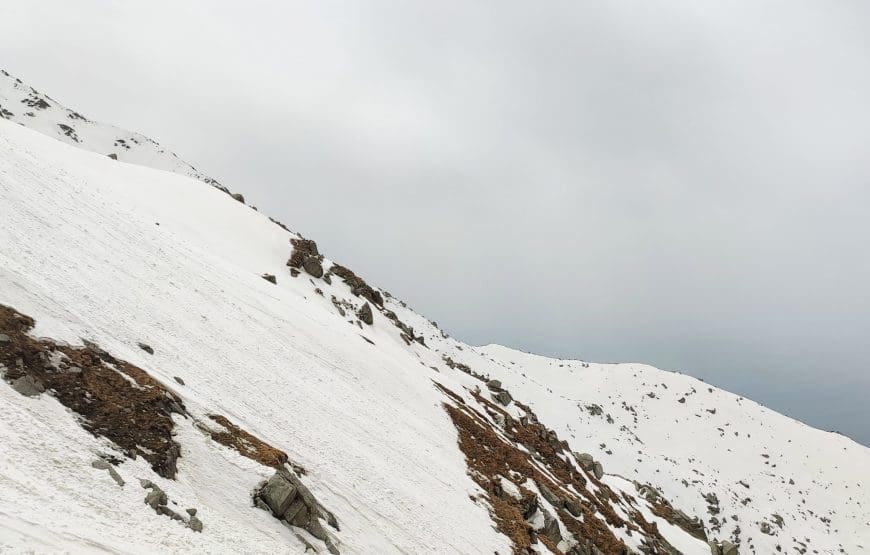
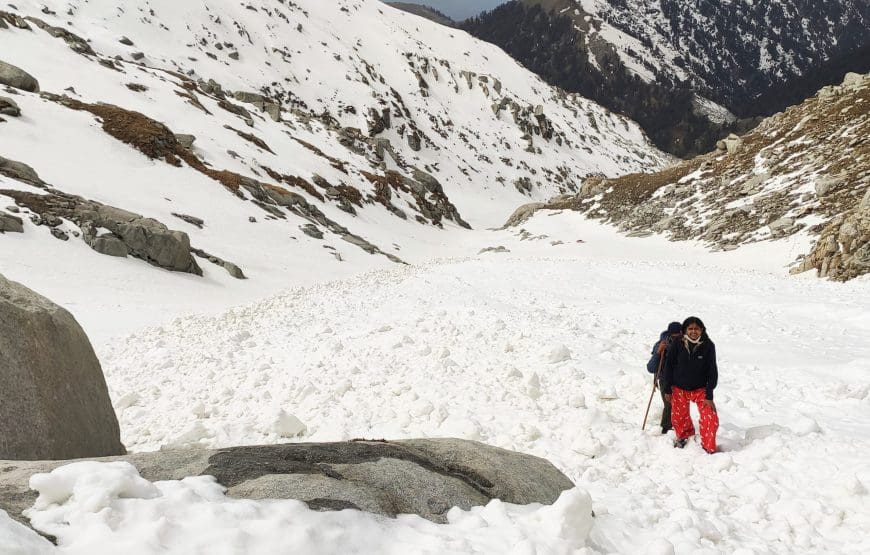
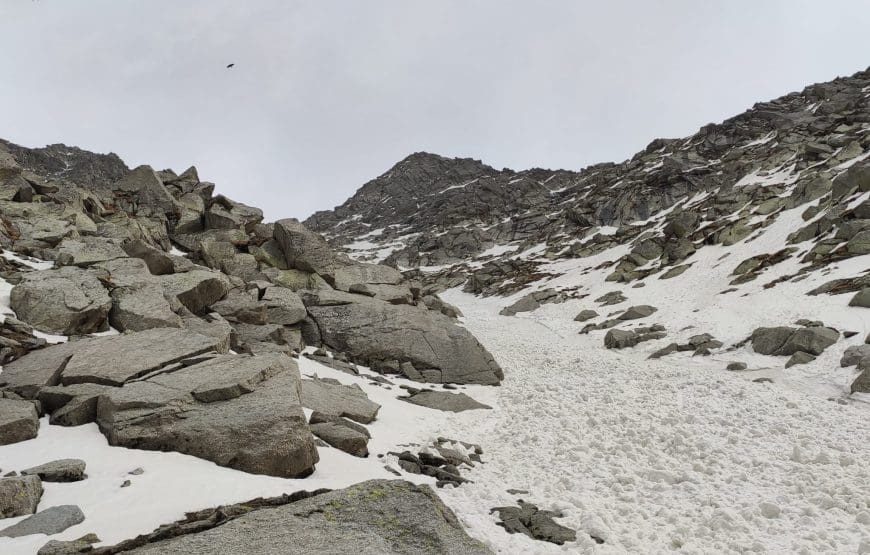
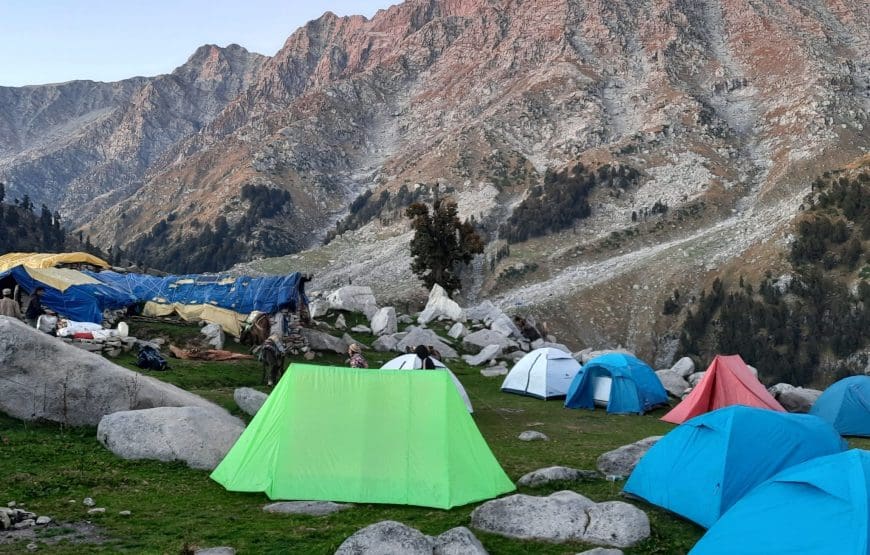
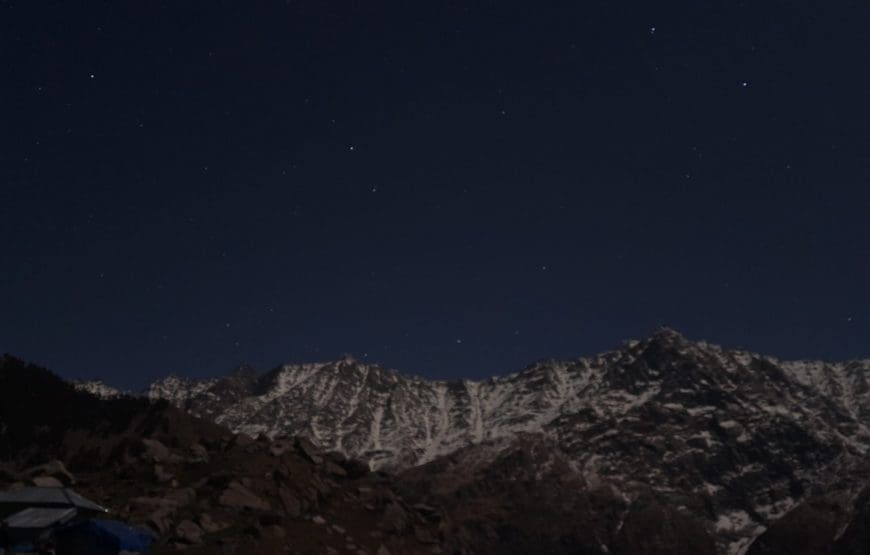
Moon Peak is a beautiful summit perched in the Dhauladhar Range of the western Himalayas. It is a moderate peak climb for the neophytes who are looking forward to doing adventurous and high-altitude treks. The altitude may be underrated by some passionate mountaineers to call it a climbing expedition, but the rise of the mountain and steepness offers all the aspects of climbing a peak.
Moon Peak comprises of moderate level of technicalities requiring adequate strength and endurance. It is a mixed climb of rocky ascends steep traverses and a strenuous summit attempt.
Moon peak is located in the rich flora and fauna valley of Kangra district ornamented with tea estates, herbal medicinal plants, and great landscapes fascinating the travelers to experience the abundance of varied atmosphere.
Moon peak in the Dhauladhar range which divides two districts of Kangra and Chamba, is often famous for their shepherds, who had discovered most of the trailing routes between far-flung regions. Moon peak route which was also a shepherd’s trail detouring from the Indrahar pass to Chamba valley in search of better pastures, has now been opted by adventure seekers as a trekking or climbing route to find acme of the Dharamshala region.
One can see the Moon Peak right from the start of the trek, rising ferociously through the clouds. The immense force during the birth of the Himalayas can be seen on this particular peak, which on one side drops greatly to the plains of Kangra valley and on the other side, snowcapped mountains surrounding the great Himalayan grandeur.
The Moon Peak, at an altitude of almost 15,125 feet, is the most visible and towering landmark in the Dhauladhar mountain range. The Moon Peak Trek starts from Mcleodganj in Dharamshala and passes through the popular camping ground of Triund, the Laka Got, Lahesh Caves, and Indrahaar Pass.
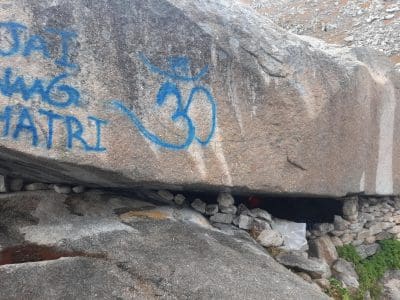
The Moon Peak trek covers an approximate trekking distance of 45 km starting from Triund top.
The temperature in Summers: 20°C to 25 °C day and falls to 5°C to 7 °C at night
The temperature in Winters: 10°C to 15 °C day and nearly 0 to -7 °C at night
Moon peak trek is a moderate to difficult trek. It is graded 6/10 in terms of the difficulty scale.
The best time for Moon Peak Trek is during May, June, September, and October.
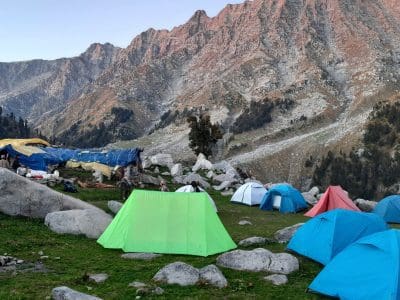 How to reach starting point – Mcleodganj
How to reach starting point – McleodganjBy Flight
Flights are available till Gaggal airport for traveling to McLeodganj. From Gaggal one can travel to McLeodganj by road. There are direct flights available from Delhi to Gaggal airport. Air India and SpiceJet airlines offer services from the Indian capital to the mountainous airport.
The Indira Gandhi International Airport at Delhi has connectivity with Indian as well as world cities. From Gaggal airport, taxis are available for McLeodganj. The McLeodganj taxi union, Nandani Travels, Bhagsu Taxi Operator Union, Himachal Holidays, Bharadwaj Taxi Services, offer travel from Gaggal airport to McLeodganj. These companies also offer online booking for taxi services.
By Bus
HRTC (Himachal Road Tourism Corporation) provides AC, deluxe and non-deluxe buses for McLeodganj from Delhi, Chandigarh, Manali, Dehradun, Pathankot, and Dharmashala. Buses originate from Tibetan colony Manju ka Tilla in Delhi, it takes around 13 hours to complete the overnight journey.
The distance of McLeodganj from various cities is, 90 km from Pathankot, 240 km from Manali, 250 km from Chandigarh, 400 km from Dehradun, and 500 km from Delhi. Multiple buses are available from Dharamsala, as it is in the lower region as compared to McLeodganj. Dharamsala to McLeodganj one can take shared taxis or buses for the short distance of 5.5 km which takes around 30 minutes to reach.
Laxmi Holidays, City Land Travels are some private travel companies offering their services other than HRTC in this region. The national highway NH 20 connects McLeodganj with the rest of the country.
By Train
Pathankot is located around 100 km from McLeodganj and is the nearest broad gauge railway station. The nearest railway station from McLeodganj is Kangra, which is a narrow-gauge railway station and it is 30 km away.
Train travel enthusiasts can take this journey to enjoy the marvels of the railway, but this journey takes a longer time as it is a toy train. There are direct trains from Ahmedabad, Delhi, Jammu Tawi, Amritsar, Tatanagar, Durg, and Haridwar. Multiple trains in a day connect Delhi and Jammu Tawi via Pathankot.
Altitude: 1,760m to 2,850m
Trek Distance: 9 km
Duration: 4-5 hours
Begin your adventure from McLeod Ganj, the vibrant hill station known as “Little Lhasa.” The trek starts from Dharamkot or Gallu Devi Temple, ascending through mixed forests of oak, deodar, and rhododendron. The trail offers a moderate climb with well-defined paths and stone steps in certain sections. As you gain altitude, enjoy panoramic views of the Kangra Valley below. Reach Triund Top by late afternoon, where you’ll be rewarded with spectacular views of the Dhauladhar range on one side and the Kangra Valley on the other. Set up camp at this scenic meadow and witness a mesmerizing sunset over the mountains.
Altitude: 2,850m to 3,200m
Trek Distance: 6 km
Duration: 3-4 hours
After an early morning sunrise view from Triund, begin the trek towards Laka Glacier. The trail becomes steeper and more challenging as you leave the tree line behind. Navigate through alpine meadows and boulder sections while enjoying close-up views of the Dhauladhar peaks. The landscape transforms dramatically as you enter the glacial valley. Reach Laka Glacier campsite, also known as Snowline Café during season. This is the base camp for Moon Peak, situated beside a small glacial pond with towering peaks surrounding the area.
Altitude: 3,200m to 4,342m to 3,600m
Trek Distance: 10-12 km
Duration: 7-8 hours
Start early for the challenging climb to Indrahar Pass, one of the most scenic passes in the Dhauladhar range. The steep ascent involves negotiating loose scree and boulder sections. Reach the pass at 4,342m, marking the boundary between Kangra and Chamba districts. Take in the breathtaking 360-degree views of the Pir Panjal range, Mani Mahesh Kailash peak, and the valleys below. Descend carefully towards the Chamba side to reach Khookdali, your campsite for the night. The descent offers stunning views of the remote valleys and distant peaks.
Altitude: 3,600m to 4,650m to 3,200m
Trek Distance: 14-16 km
Duration: 10-12 hours
Begin the summit attempt in the early hours (around 2-3 AM) for Moon Peak. The initial trail involves a gradual ascent followed by a steep climb on rocky and potentially snowy terrain. Use of basic mountaineering equipment may be required depending on conditions. Reach the summit of Moon Peak (4,650m) by sunrise to witness spectacular panoramic views of the Greater Himalayas, including peaks in Lahaul, Spiti, and even distant Ladakh ranges on clear days. After spending time at the summit and capturing memories, begin the long descent back to Laka Glacier campsite, retracing your route through Khookdali.
Altitude: 3,200m to 1,760m
Trek Distance: 15 km
Duration: 6-7 hours
Start the final descent after breakfast, retracing your path through Triund. The downhill journey, though easier on the lungs, can be challenging on the knees. Take regular breaks and enjoy the changing landscapes as you descend from alpine zones back into forests. Stop at Triund for a final glimpse of the majestic Dhauladhar range and a quick refreshment break. Continue descending through the forest trail, reaching Gallu Temple or Dharamkot by afternoon. From here, it’s a short walk or drive back to McLeod Ganj, where your memorable Moon Peak expedition concludes.
With fully adjustable suspension system and loops and easy to open compartments access.
A reusable water bottle/hydration flask – 1.5-2L
Nutrient-dense with oats, nuts, seeds, and fruit.
Warm and waterproof clothing for winters, wind and waterproof jackets for monsoon, breathable clothing for summers.
Fleece/padded jacket to keep you warm.
Sunscreen, hat, sunglasses Etc
Waterproof & windproof rain jacket for winters.
Lightweight and a textured grip with rechargeable batteries.
When the weather changes in the mountains (as it happens every few hours), you can take off or put on layers as required.
Lightweight – cotton/bamboo/linen/microfiber easy to dry.
Hand sanitizer, biodegradable soap, toothbrush, toothpaste, cotton washcloth,
unscented wet wipes, toilet paper, a menstrual cup (if necessary), or feminine hygiene products and a sealable plastic bag to carry them out. a sizeable plastic bag to do laundry in.
First aid for emergencies
Normal kitchen garbage bags to keep the trails you trek beautiful, clean, and free of garbage.
Vaseline/Cold cream to keep your skin from drying out.
A pack of tissues is always useful in any case.
With flexible sole and good grip, water-resistant.
Breathable, durable, absorbent, and insulating ability to keep your hands warm.
Woolen skull cap/hats with fleece lining for winter treks.
Altitude: 1,760m to 2,850m
Trek Distance: 9 km
Duration: 4-5 hours
Begin your adventure from McLeod Ganj, the vibrant hill station known as "Little Lhasa." The trek starts from Dharamkot or Gallu Devi Temple, ascending through mixed forests of oak, deodar, and rhododendron.
The trail offers a moderate climb with well-defined paths and stone steps in certain sections. As you gain altitude, enjoy panoramic views of the Kangra Valley below.
Reach Triund Top by late afternoon, where you'll be rewarded with spectacular views of the Dhauladhar range on one side and the Kangra Valley on the other.
Set up camp at this scenic meadow and witness a mesmerizing sunset over the mountains.
Altitude: 2,850m to 3,200m
Trek Distance: 6 km
Duration: 3-4 hours
After an early morning sunrise view from Triund, begin the trek towards Laka Glacier. The trail becomes steeper and more challenging as you leave the tree line behind.
Navigate through alpine meadows and boulder sections while enjoying close-up views of the Dhauladhar peaks. The landscape transforms dramatically as you enter the glacial valley.
Reach Laka Glacier campsite, also known as Snowline Café during season. This is the base camp for Moon Peak, situated beside a small glacial pond with towering peaks surrounding the area.
Altitude: 3,200m to 4,342m to 3,600m
Trek Distance: 10-12 km
Duration: 7-8 hours
Start early for the challenging climb to Indrahar Pass, one of the most scenic passes in the Dhauladhar range. The steep ascent involves negotiating loose scree and boulder sections.
Reach the pass at 4,342m, marking the boundary between Kangra and Chamba districts. Take in the breathtaking 360-degree views of the Pir Panjal range, Mani Mahesh Kailash peak, and the valleys below.
Descend carefully towards the Chamba side to reach Khookdali, your campsite for the night. The descent offers stunning views of the remote valleys and distant peaks.
Altitude: 3,600m to 4,650m to 3,200m
Trek Distance: 14-16 km
Duration: 10-12 hours
Begin the summit attempt in the early hours (around 2-3 AM) for Moon Peak. The initial trail involves a gradual ascent followed by a steep climb on rocky and potentially snowy terrain. Use of basic mountaineering equipment may be required depending on conditions.
Reach the summit of Moon Peak (4,650m) by sunrise to witness spectacular panoramic views of the Greater Himalayas, including peaks in Lahaul, Spiti, and even distant Ladakh ranges on clear days.
After spending time at the summit and capturing memories, begin the long descent back to Laka Glacier campsite, retracing your route through Khookdali.
Altitude: 3,200m to 1,760m
Trek Distance: 15 km
Duration: 6-7 hours
Start the final descent after breakfast, retracing your path through Triund. The downhill journey, though easier on the lungs, can be challenging on the knees.
Take regular breaks and enjoy the changing landscapes as you descend from alpine zones back into forests. Stop at Triund for a final glimpse of the majestic Dhauladhar range and a quick refreshment break.
Continue descending through the forest trail, reaching Gallu Temple or Dharamkot by afternoon. From here, it's a short walk or drive back to McLeod Ganj, where your memorable Moon Peak expedition concludes.
Leave a Reply